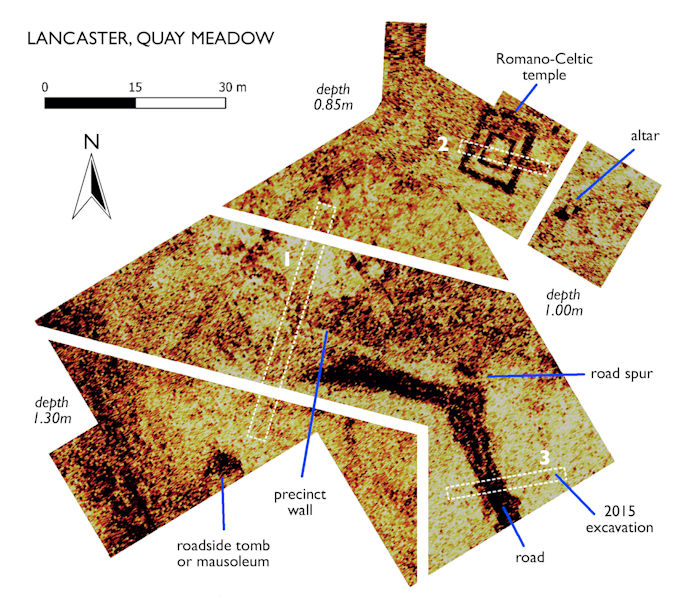Jan Bartek – AncientPages.com – Lancaster University staff and student researchers have discovered evidence of a Romano-Celtic temple under public land near Lancaster Castle – only the second of its type found in northern Britain.
What started as a team-building exercise to train a group of Ph.D. hydrogeophysics researchers to use specialist equipment ended up providing evidence of an extensive religious enclosure lying just outside the Roman military fort at Lancaster.

Image credit: Jason Wood, Andrew Binley from Lancaster Environment Centre and British Archaeology magazine Nov/Dec 2022
Professor Andy Binley, an expert in hydrogeophysics at Lancaster Environment Centre, offered to use his research expertise and equipment to continue the work of the Beyond The Castle archaeological project, when heritage lottery funding ran out in 2017.
“I had a few Ph.D. students doing geophysical research and thought this was an interesting group hobby project, training them on techniques and getting them to work as a team,” said Professor Binley, who uses geophysical methods to solve hydrological problems, such as ᴀssessing underground water in agriculture and tracking groundwater contamination.
Lancaster had a large military fort and garrison in Roman times. It was an important command centre between Chester and Hadrian’s Wall and a base for naval operations and supply. The Beyond the Castle project had been using standard geophysical techniques followed by trial excavation to explore the green open space between Lancaster Castle and the River Lune. These had revealed evidence of a building, thought to be a Roman warehouse, under an area called Quay Meadow, owned by Lancaster City Council. But Professor Binley and his students would make much more extensive, and exciting discoveries.
“What Andy brought to the project was much more sophisticated techniques and up to date equipment and someone from outside archaeology to apply a critical eye,” said the Beyond the Castle project’s leading archaeologist, Jason Wood. “The Roman archaeology in this area of Lancaster is very shallow because it hasn’t been built on. Consequently the archaeological layers are much nearer the surface, so there is wonderful potential.”
Professor Binley soon got hooked and involved more students doing multiple surveys, including visiting researchers from China, Italy and Iran, and some masters and undergraduate students doing research for their degrees.
“Like Time Team, we looked under the ground without disturbing it, doing measurements on the surface. We used ground penetrating radar, which fires a pulse of energy into the ground and gets reflections from what lies underneath,” said Professor Binley.
They also used a technique called resistivity mapping, injecting electricity into the ground to measure its resistance to electricity – remains like stone walls are much more resistive to electricity than soil. Although similar techniques have been used elsewhere in archaeological surveys, this was the first time some of these techniques and equipment had been used at the Lancaster site.
Dr. Guillaume Blanchy, who was doing his Ph.D. at Lancaster University using geophysical techniques to monitor soil moisture change in agriculture, ended up organising a lot of the investigations.
“In the beginning we were just trialling the equipment, then we were training others and then we just got a bit enthusiastic about the site, and wanted to map the entire field,” said Dr Blanchy.
These techniques, along with follow up coding and modelling by the researchers, produced much clearer 3D images than previous surveys conducted at the site. When Mr. Wood saw the results he became excited.
“We found some extraordinary things. I thought the area would be archaeologically sterile but to my great surprise it seemed to be stuffed with archaeology dated to the Roman period.”
The major discovery was what Jason believes is a Romano-Celtic temple – only the second such temple found in Northern Britain – the other one is close to Hadrian’s Wall.
These temples have a very specific design – two sets of walls forming a square within a square, with a very small interior.
“It would have been dedicated to a god, probably ᴀssociated with the sea or river. The inner sanctum was reserved for the priests, the outer ambulatory space was for elite members of society,” said Mr. Wood.
“Most of the religious activities would have happened outside the temple, including sacrifices. There would have been a sanctuary or enclosure, possibly with another temple and buildings ᴀssociated with hospitality and curing the sick. The enclosure would have been separate from the fort, but connected to it by a road or processional way.”
Professor Binley and his students’ surveys confirm this, seeming to show the wall of the enclosure, with a gateway leading to a processional way. They also show a possible roadside mausoleum outside the enclosure and what might be the base of an altar close to the temple.
See also: More Archaeology News
“So few of these sites have been excavated in the UK, so it is significant to have found a Romano-Celtic temple in its temenos (enclosure) by a river,” said Mr. Wood.
“We couldn’t have interpreted the site without Lancaster University, and it was all done at no cost to ourselves, using techniques and related software not freely available.”
Written by Jan Bartek – AncientPages.com Staff Writer





